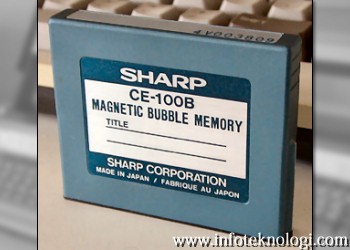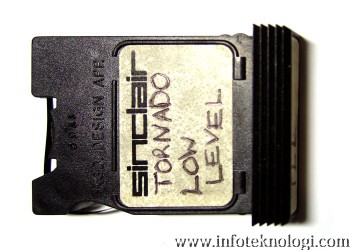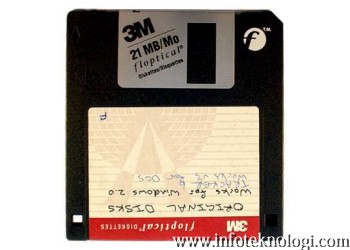On this day of storage media (storage) such as BlueRay, DVD ROM, and flash capable of storing data in Gigabyte, while for the hard disk already exists that has a capacity of more than 1 Terabyte.
When we remember the past few years with a capacity of 1 GB hard drive is a luxury item for computer users, and considering even further behind their floppy 5 1 / 4 inch ever known with a capacity of only 720KB.
When we remember the past few years with a capacity of 1 GB hard drive is a luxury item for computer users, and considering even further behind their floppy 5 1 / 4 inch ever known with a capacity of only 720KB.
It's good nostalgia to the past we saw some storage media that ever existed and were used in the computer world. Infoteknologi will not discuss the history of data storage media such as 3.5 inch floppy, LS-120, or tape drive. But it will discuss the storage media that have been produced but is not / less successful in the sales process.
A consortium of manufacturers led by Matsushita introduced the diskette with size of 3 inches in 1983 to rival the 3.5 inch floppy made by Sony.
3-inch diskettes 140KB accommodate every side, used the British Amstrad computer, but this format is also lost and unable to compete with a 3.5 ".
3-inch diskettes 140KB accommodate every side, used the British Amstrad computer, but this format is also lost and unable to compete with a 3.5 ".
Sharp Bubble Memory

Bubble memory is a crowded media echoed by industry analysts to be a substitute for magnetic disk media. But reality says another, bubble memory is only used in some commercial products.
One of them was the Sharp PC-5000, early models of IBM (1983). Computers that use the Sharp CE-100B Magnetic Bubble Memory cartridge as the primary storage medium; each cartridge capable of storing data 128kB.
Apple Twiggy Diskette

Apple Lisa (1983) using two 5.25-inch disk drives are integrated. These drives use the format "Fileware", but many who knew him by name Twiggy. Twiggy diskettes with a capacity of 871KB and is seen as a version of "strange" from version 5.25 diskette icon.
Apple realizes that the diskette is not good and easily damaged, then Apple stopped this format and replace it with Sony's 3.5 inch diskette with a capacity of 400kb on the next version of the Apple Lisa (1984)
Sinclair ZX Microdrive

In 1983, Sinclair Research launched the ZX Microdrive system for their computer systems ZX Spectrum. ZX Microdrive can store 85KB in media of 1.3 inches.
Microdrive read and write data faster than tape drives tape in that era, but this format is also more easily damaged.
IBM PCjr Cartridge ROM

Usually we will assume catridge ROM as traditional storage media in video game consoles, but the computer also had to wear antiquity. Uniquely, Lotus has released their popular software Lotus 1-2-3 in the format of the IBM PCjr in 1984. Although the media is quick to access data and easy to use, cartridge ROM fast losing its popularity due to the limited amount of data that can be stored and also the manufacturing cost of this media.
2-Inch Floppy Disk

First designed for use on early video recorder, Fuji LT-1 2-inch floppy format is used only on computers with laptops Minisport Zenith model (1989). Disk capacity is set at 720 KB, and because of their small size, there is mockery in that era so that users are advised to keep animals in because they might be swallowed.
Floptical Diskette

Insight Peripherals floptical drive introduced in 1992. This media is capable of storing 21 MB of data on 3.5-inch floppy disks, and floppy drives are also compatible with 3.5 inch. Floptical capable of storing larger data through hybrid technology called "Floppy Optical" which combines a conventional disk technology with reading data through a laser that allows the writing of more accurate data, which allows more tracks are stored on floppy disks. © haxims.blogspot.com
Canon Optical Card

This storage medium can store two megabytes of data on optical and after entering data in it then there will never be replaced (just like CD-R, but not spinning)
Tested as the world's medical identification card in 1990, but then disappeared without a trace echo.
Hitachi Micro Hamster
Photo above is the official photo of Hitachi's ads featuring a hamster and Compact Flash hard drive called the Microdrive.
Deperkenalkan first time in 2003, a small hard drive offers a large size with a powerful performance, plus a per-megabyte pricing is less expensive than flash media.
But then a flash media experience great improvement in terms of capacity peninggakan, these miniature hard drives and then lose the market.
Deperkenalkan first time in 2003, a small hard drive offers a large size with a powerful performance, plus a per-megabyte pricing is less expensive than flash media.
But then a flash media experience great improvement in terms of capacity peninggakan, these miniature hard drives and then lose the market.
Magneto-Optical Disk

Magneto uses laser technology to read data on cakramnya, much like the CD-ROM.But unlike the CD, most of MO discs can be rewritten because it uses a special magnetic materials combined with laser technology.
Magneto disks first became known after being used on the NeXT Computer in 1988.Various MO drives are still manufactured today, but far behind the media echo a kind of conventional DVD-R.
source : http://www.infoteknologi.com/

No comments:
Post a Comment